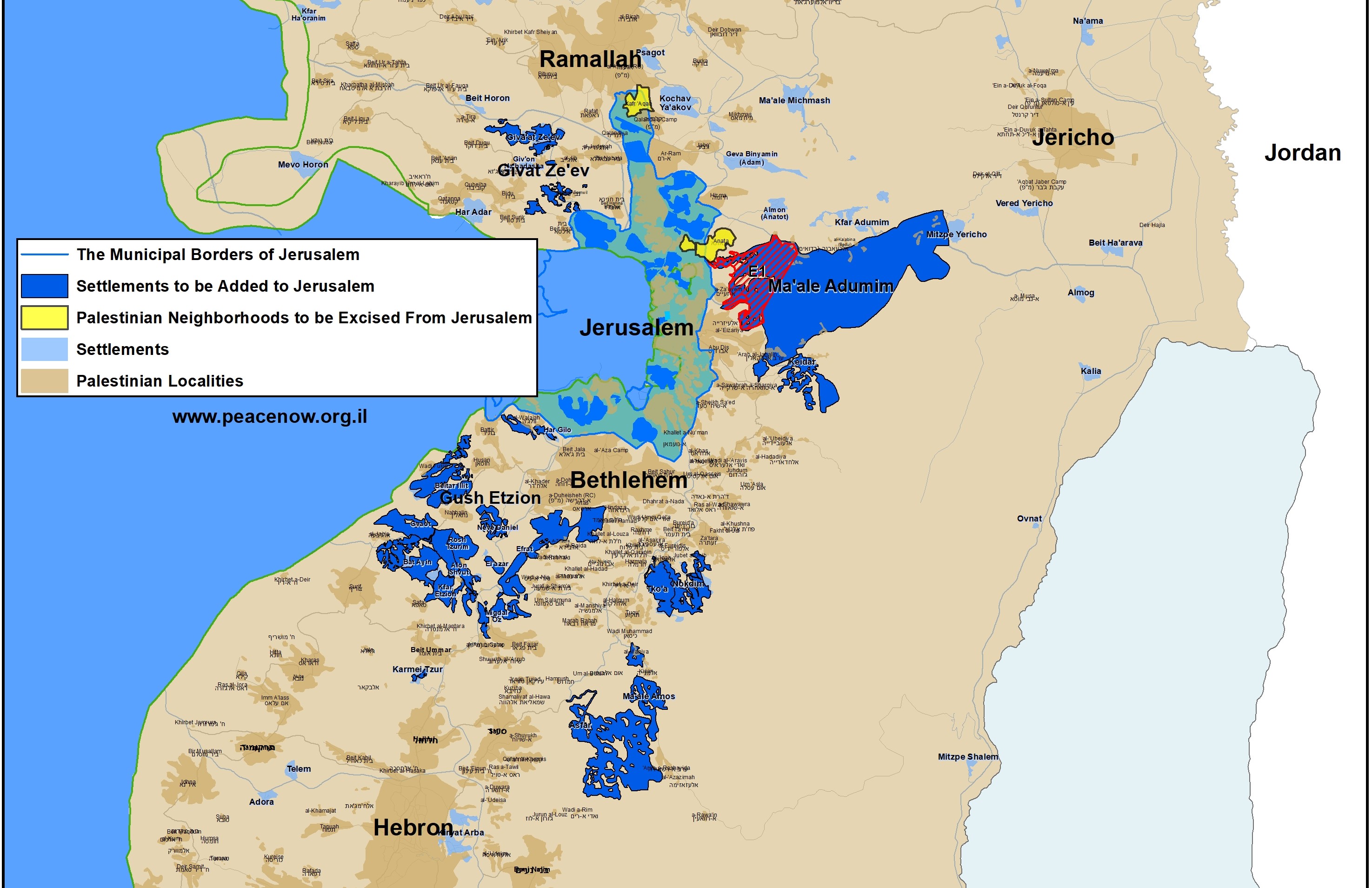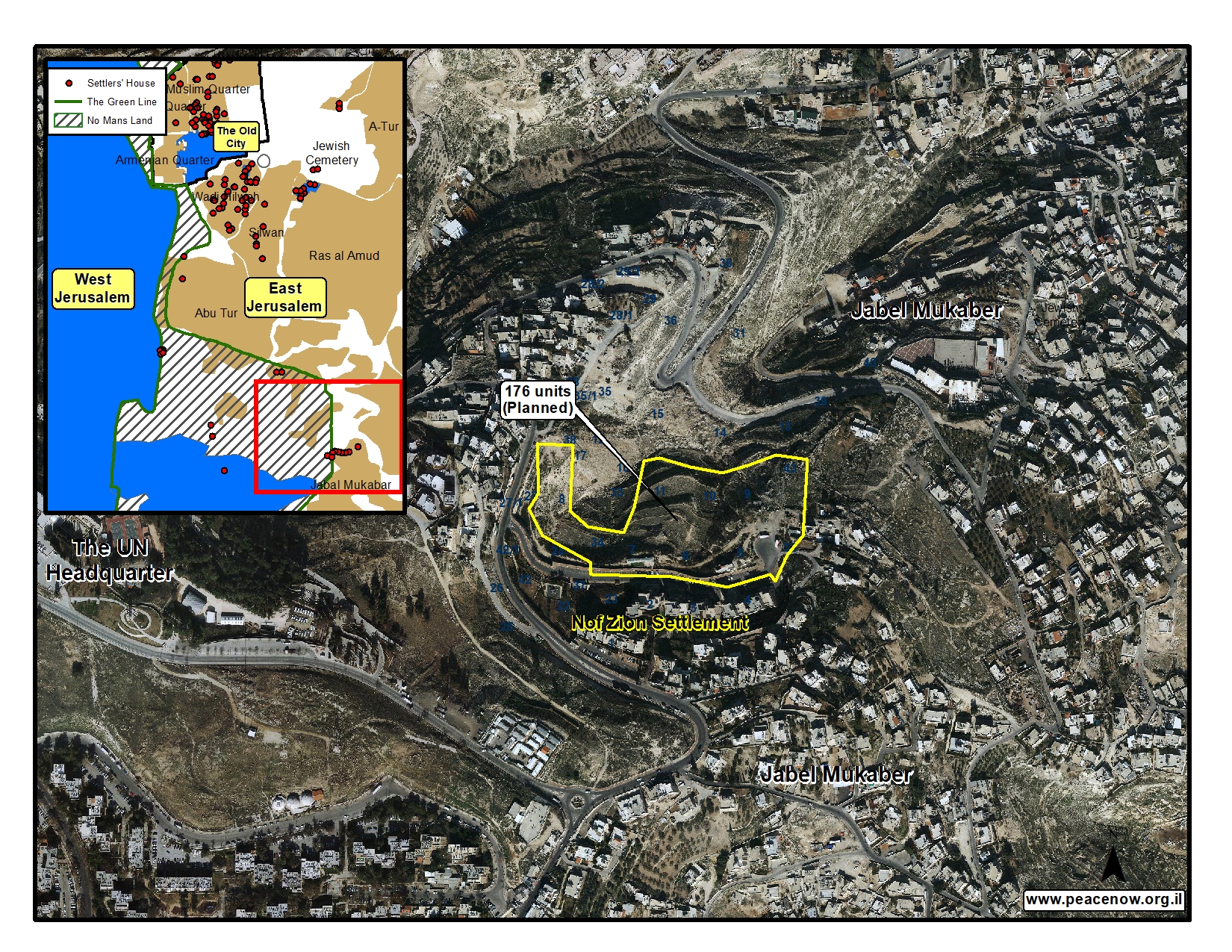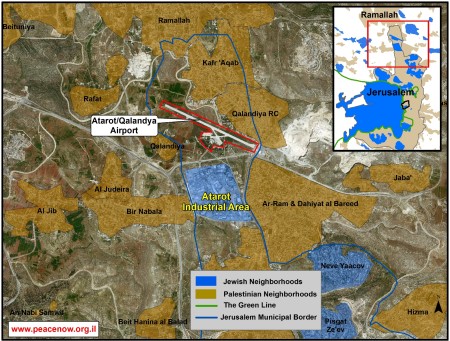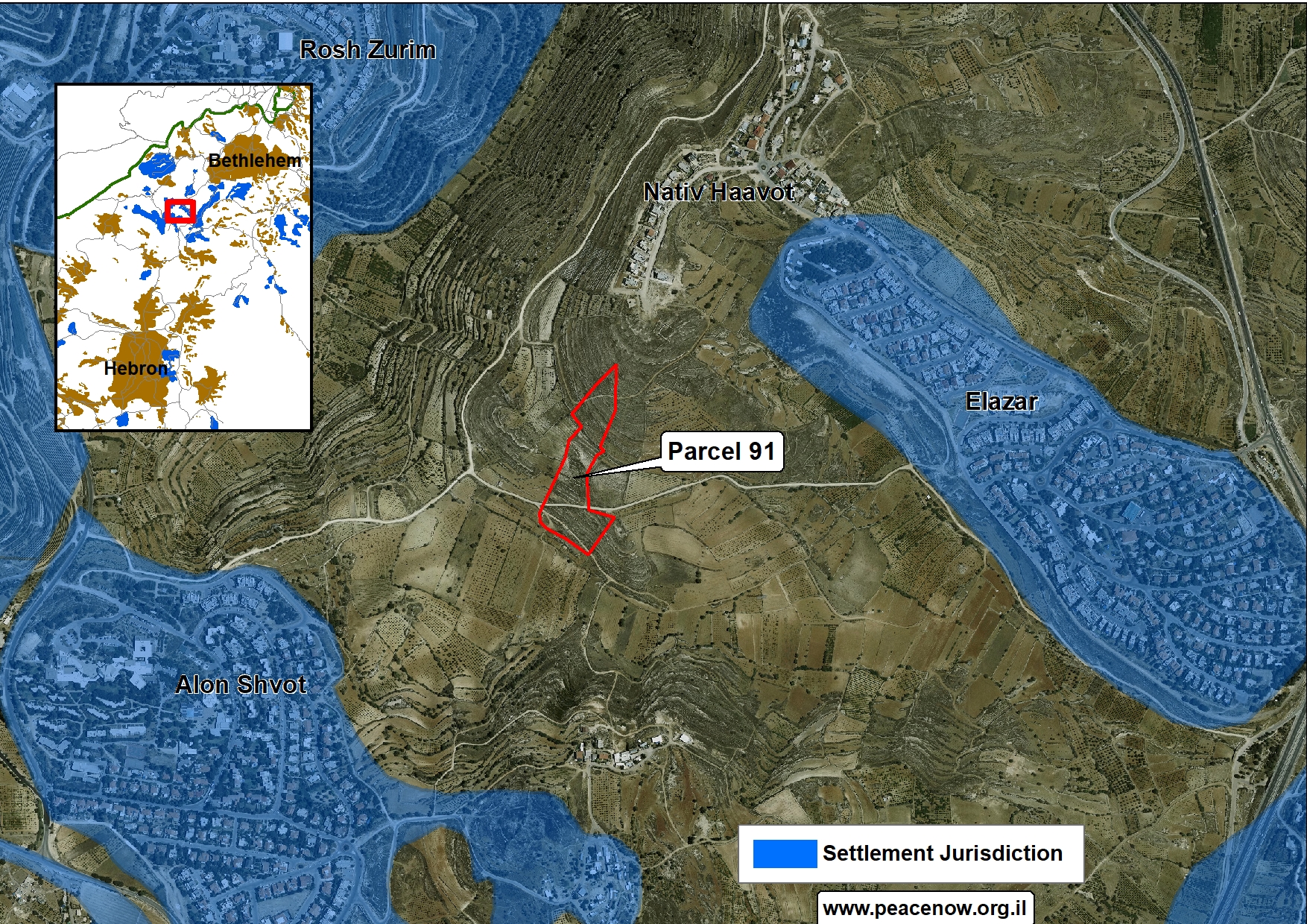Welcome to FMEP’s Weekly Settlement Report, covering everything you need to know about Israeli settlement activity this week.
To receive this report via email, please click here.
October 26, 2017
- Assault on Jerusalem [And a Negotiated Solution], Part 1: Cabinet to vote Sunday on “Greater Jerusalem [Annexation] Bill,” with Netanyahu’s Backing
- Assault on Jerusalem [And a Negotiated Solution], Part 2: East Jerusalem Settlement Enclave in Jabal Mukaber Set to Triple in Size
- Assault on Jerusalem [And a Negotiated Solution], Part 3: First New East Jerusalem Settlement in Decades, Atarot, Is Inching Closer Towards Construction
- The New U.S. Settlement Policy: Expand at Will, but Don’t Surprise Us
- Israeli Justice Minister Personally Involved in Drafting State Responses to Settlement Petitions before the High Court of Justice
- Updates: Netiv Ha’avot and the “Settler Security Package”
- Bonus Reads
Comments, questions, or suggestions? Email Kristin McCarthy at kmccarthy@fmep.org.
Assault on Jerusalem [And a Negotiated Solution], Part 1: The “Greater Jerusalem [Annexation] Bill” is Set for a Vote on Sunday with Netanyahu’s Backing
The Israeli Knesset reconvened on Monday for it finals session of the year; in addition to a litany of anti-democratic bills [Americans Peace Now published an excellent explainer of those bills here], Netanyahu has reportedly signalled the Knesset to pass the “Greater Jerusalem Bill” [text here]. With Netanyahu’s approval, the bill is expected to be come up for a vote in the Cabinet on Sunday, October 29th, and after that to be sent to the Knesset.
If passed into law, the “Greater Jerusalem Bill” will:
-
Effectively annex a an enormous area of the West Bank into Israel’s Jerusalem Municipality, including not only the settlements but huge areas of adjacent land designated by Israel as belonging to the settlements. Peace Now has a map of the settlements/land that will annexed [click for greater detail].
- Include as part of Jerusalem settlements/lands located far from the current borders of Jerusalem, extending deep into the West Bank nearly to Jericho (the Palestinian city located on the border with Jordan) and including settlement located closer to Hebron than to Jerusalem.
- Effectively annex the area of the planned E-1 settlement, the same area where the Khan al-Ahmar community continues to await the fate of Israel’s plan to forcibly relocate them (a war crime) out of the area.
- Redraw the borders of the Jerusalem Municipality to cut out several Palestinian neighborhoods that are legally part of the Municipality but that Israel elected to leave on the West Bank side of its separation barrier (these neighborhoods would have new “sub-municipalities” created for them).
PLO Executive Committee member Hanan Ashrawi stated bluntly “such efforts represent the end of the two-state solution.”
The anti-settlement watchdog Peace Now writes,
The bill states that its implementation would allow to maintain a “demographic balance” between Jews and Palestinians in Jerusalem, and will allow for the expansion of construction of housing units and industry in the area. It is clear that the idea is to allow rapid settlement construction in settlements near Jerusalem and create facts on the ground which will prevent the chance for a two state solution, and at the same time excise Palestinian neighborhood by the formation of “sub-municipalities” or if you will, Bantustans, devoid of resources which will allow them to be self-sufficient.
J Street writes that passage of the bill,
would be a major step in Israel’s ongoing, de facto annexation of territory throughout the West Bank – and pose a massive threat to the possibility of ever achieving a two-state solution. If carried out, Israel would be crossing a major red line by unilaterally imposing its own solution to a vital final status issue.
In addition to the “Greater Jerusalem Bill,” a second bill regarding Jerusalem is also on the Knesset’s winter docket. If passed, this bill would amend Israel’s Basic Law to require a supermajority – 80 out of 120 votes – in the Knesset to approve any deal that transfers sovereignty over any part of Jerusalem to a foreign entity. This gives the Knesset veto power over any future peace deal reasonably assuming that the Palestinians will not agree to cede all of Jerusalem (it’s historic capital and home to sacred religious and national sites) to Israel.
Americans for Peace Now explains,
If passed into law, this measure would be unmatched in the Israeli legal code. No other Israeli government executive decision requires a two-thirds majority. This legislation would tie the hands of future governments in negotiating peace and will grant a de facto veto to representatives of the Israeli public’s anti-peace minority. The bill passed an initial vote and will need to pass three additional readings to become law. The absurdity is that the law, if passed, will surely garner significantly fewer than the 80 votes it demands for a future decision on Jerusalem.
Earlier this month, when these two bills were first unveiled, Terrestrial Jerusalem’s founder Danny Seidemann warned:
Cumulatively, these … initiatives constitute an effort to implement the most radical changes in the status of East Jerusalem since the Israeli annexation in June 1967, and threaten to profoundly detrimental impacts on the prospects of a future political agreement. Indeed, it is difficult to overestimate their significance. Together they would create a radically new geopolitical reality in Jerusalem and its environs.
Ir Amim also cautions:
The bills have not surfaced in a vacuum; they complement a series of recent initiatives calculated to impose crucial territorial-political facts on the ground under the guise of “municipal moves.” They would preempt chances of a political resolution to the conflict, weaken the urban fabric, and ratchet up tensions in Jerusalem.
Assault on Jerusalem [And a Negotiated Solution], Part 2: East Jerusalem Settlement Enclave in Jabal al-Mukaber Set to Triple in Size
In addition to the wave of settlement approvals by the Israeli High Planning Council last week [read last week’s Settlement Report here], on Oct. 25th, the Jerusalem Municipality issued conditional building permits for 176 new units in the Nof Zion settlement enclave. The permits are pending until the settlers submit proof of ownership papers; the missing paperwork has delayed the issuance of the permits since the plan was first leaked in early September (it’s not clear what has changed to allow for them to be issued now).
Nof Zion is inside the Palestinian neighborhood of Jabel al-Mukaber in occupied East Jerusalem. The new units will nearly triple the size of the enclave, making it the largest of its kind in East Jerusalem.
When reports of the building permits for Nof Zion surfaced earlier this year, it sparked outrage and concern over unrestrained settlement growth in East Jerusalem and its impacts on the future of Jerusalem. The same concerns are now more urgent and alarming, as it appears there are no settlement plans too controversial for the Netanyahu government to greenlight.
Ir Amim writes,
The primary objective of the settlers’ infiltration into the Palestinian neighborhoods in and around the Old City is to undermine the possibility of dividing Jerusalem, thereby foiling the possibility of a political resolution on the city and an end to the Israeli-Palestinian conflict. The building permits will issue a clear statement that the Israeli government sanctions and supports the establishment of new facts on the ground designed for this purpose.
Assault on Jerusalem [And a Negotiated Solution], Part 3: First New, Government-Backed East Jerusalem Settlement in Decades, Atarot, Inches Closer Towards Construction
In a move described by city planning experts as “nothing less than fantasty,” the Israeli government has set aside millions of shekels to build 10,000+ units in a new settlement planned at the site known as Atarot, in the northern part of East Jerusalem. If implemented, Atarot would be the first new government-backed settlement established in East Jerusalem since the construction of Har Homa in the 1990s [unless plans to move ahead with the new settlement of Givat Hamatos come to fruition first – in that case, Givat Hamatos would be the first new government-backed settlement established in East Jerusalem since the early 1990s; Atarot would be the second].
The planned Atarot settlement would be located in the northern part of the East Jerusalem, extending to the southern edge of the West Bank city of Ramallah. It would include 10,000+ units for ultra-Orthodox Jewish Israelis. The location for construction is site of the disused Atarot airport. The airport site is an important commodity, reportedly promised to the Palestinians for their state’s future international gateway. Developing the site into a Jewish Israeli settlement would deprive a future Palestinian state of the only airport in the West Bank, dismember Palestinian neighborhoods in the norther part of the city, and sever East Jerusalem from a Palestinian state on this northern flank of the city (acting like E-1 on Jerusalem’s northeast flank, and like Givat Hamatos on Jerusalem’s southern flank).
FMEP first reported on Atarot in April 2017 when the settlement plan was rumored to be included on the master blueprint of settlements for which Netanyahu intended to seek U.S. approval. It was expected to be announced in May on the occasion of the Jerusalem Day celebration, but until now, the plan has not advanced.
The plan dates back to 2007; it was pursued by the Israeli government in 2012 but shelved under pressure from the Obama administration. At that time, Peace Now’s Hagit Ofran observed:
Not only that this plan might severely harm the future Palestinian State, destroying the only airport in the West Bank, but it will also cut between East Jerusalem and Ramallah at the heart of many Palestinian neighborhoods: Shu’afat and Beit Hanina in the South, Bir Nabala, Al Judeira, Al Jib, Rafat and Qalandia in the West, Ar-Ram, Dahiyat al Bareed and Jaba’ from the East, and Qalandia Refugee Camp, Kafr ‘Aqab and Ramallah from the North. It seems that what the Givat Hamatos plan is meant to do in the South of Jerusalem (to cut between Bethlehem and East Jerusalem), this plan will, god forbid, do at the North of it. The goal of this plan is clear: to prevent the possibility of a Palestinian State in the West Bank, and thus to kill the two states solution.
This week, Peace Now commented:
This is a crazy plan, both politically and in terms of planning. It is an attempt to drive a wedge into the heart of an urban area of hundreds of thousands of Palestinians. Since the neighborhood of Har Homa was established in the 1990s, no new Israeli neighborhood has been built beyond the Green Line in Jerusalem.
Reported New U.S. Settlement Policy: Expand at Will, but Don’t Surprise Us
According to a report posted on Al-Monitor, two months of secret negotiations between the U.S. and Israel have resulted in an unofficial framework for how Israel, with U.S. approval, will advance and expand settlements. The agreement reportedly entails the following:
- The U.S. will see all settlement plans Israel has decided to approve before they are advanced bureaucratically (i.e., before moves that allow them to become public).
- Israel can approve plans for new settlement units anywhere that is adjacent to an existing unit (read: in any/all/every settlement or outpost).
- With respect to the West Bank, there is an unspecified limit on the quantity of new units that each new settlement project is allowed.
- With respect to East Jerusalem, there is no limit on the number of units allowed to advance as long as rules 1 & 2 are respected.
It should be noted that the only plan that appears to violate the letter of this leaked deal is the plan for the Atarot settlement in East Jerusalem, which is not adjacent to any existing units (rule #2).
Israeli Justice Minister Personally Involved in Drafting State Responses to Settlement Petitions before the High Court of Justice
Israeli Justice Minister Ayelet Shaked is coming under fire for her intervention in every case before the High Court related to Israeli settlements and unauthorized outposts. Haaretz reported this week that since being appointed, Shaked has retained the services of a private lawyer to review and redraft each and every state response related to settlements and outposts before that response is submitted to the High Court of Justice. Moreover, the lawyer Shaked selected for this task comes from the notorious far-right, pro-settler group Regavim — a group that devotes its efforts to systematically mapping out and expelling Palestinians from strategic areas in Jerusalem, the West Bank, and the Negev.
Further Haaretz reporting revealed the Israeli Attorney General Avichai Mandleblit and the State Prosecutor Shai Nitzan (whose office ostensibly produces the first draft of state responses that Shaked then edits) have defended Shaked against criticism for this heavy handed political interference in legal matters.
Updates: Netiv Ha’avot and the “Settler Security Package”
-
The Israeli High Court dismissed a state-backed petition by settlers challenging the planned demolition of 17 structures built wholly or partly on privately-owned Palestinian land in the unauthorized outpost of Netiv Ha’avot. The settlers asked that 15 of the structures only be partially demolished, leaving intact the portions of them that are not on Palestinian land. The Court rejected the request and ordered the structures to be demolished. The entire outpost of Netiv Ha’avot is slated to be razed by March 2018 following a High Court ruling. Just last week, the High Planning Council approved a plan (a plan it called “improper” but approved anyway) to build 17 temporary new homes for Netiv Ha’avot residents on lands between the Elazar and Alon Shvut settlements. This land parcel is outside of either of the settlements’ jurisdictions – in effect, it is another case of rewarding settlers for breaking the law by “compensating” them with the establishment of a brand-new settlement. However, to avoid the appearance that this is the case, the High Planning Council ordered the borders of Alon Shvut to be formally expanded before the structures are built to include the parcel (which would mean that the plan would not, retroactively, violate the new U.S.-Israeli policy understanding reported previously).
- Settlers continued to protest Netanyahu even after news last week that the government plans to dispense $939 million in 2019 for the “settler security package” they are demanding. In an attempt to placate the settlers’ demands, Netanyahu met with the settler leaders to speed up his government’s timeline for beginning the West Bank settlement infrastructure projects, outlining a plan to invest $228 million beginning in next year. According to the unwritten plan, the 2018 projects will include paving five new settler-only highways to bypass Palestinian villages.
Bonus Reads
- “Dangerously ‘imprecise’ on Israeli settlements” (Americans for Peace Now)
- “Unprotected: Detention of Palestinian Teenagers in East Jerusalem” (B’Tselem & HaMoked)
- “Settler Leaders Appeal to High Court Over Bypass Road” (Jerusalem Post)
FMEP has long been a trusted resource on settlement-related issues, reflecting both the excellent work of our grantees on the ground and our own in-house expertise. FMEP’s focus on settlements derives from our commitment to achieving lasting Israeli-Palestinian peace, and our recognition of the fact that Israeli settlements – established for the explicit purpose of dispossessing Palestinians in the West Bank and East Jerusalem of land and resources, and depriving them of the very possibility of self-determination in their own state with borders based on the 1967 lines – are antithetical to that goal.



